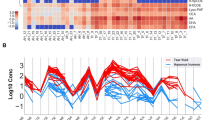Abstract
We describe a new concept implicating oxidized cholesterol derivatives and very long-chain fatty acids as possible factors in the development of corneal opacification after death. Corneal tissues, removed from both fresh and stale fish eyes, were examined for cholesterol derivatives and fatty acids after methanolysis of lipids. Cholesta-3,5-dien-7-one, cholest-4-en-3-one, hexacosanoic acid, and hexacosenoic acid were identifiedvia gas chromatography/mass spectrometry in opacified corneas, but not in significant amounts in fresh ones. The present study confirmed the presence of lipid hydrolysis and a peroxidation process in the opacified cornea.
Similar content being viewed by others
Abbreviations
- El:
-
electron impact
- GC/MC:
-
gas chromatography/mass spectrometry
- Rt:
-
retention time
- SIM:
-
selected-ion-monitoring
References
Camps, F.E., Robinson, A.E., and Lucas, B.B. (1976)Gradwohl's Legal Medicine, 3rd edn., John Wright & Sons Ltd., Bristol.
Mittag, T. (1984) Role of Oxygen Radicals in Ocular Inflammation and Cellular Damage,Biochim. Biophys. Acta 39, 759–769.
Nayak, M.S., Kita, M., and Marmor, M.F. (1993) Protection of Rabbit Retina from Ischemic Injury by Superoxide Dismutase and Catalase,Invest. Ophthalmol. Vis. Sci. 34, 2018–2022.
Sevanian, A., and Peterson, A.R. (1986) The Cytotoxic and Mutagenic Properties of Cholesterol Oxidation Products,Food Chem. Toxicol. 24, 1103–1110.
Smith, L.L., and Johnson, B.H. (1989) Biological Activities of Oxysterols,Free Radical Biol. Med. 7, 285–332.
Peng, S.K., and Morin, R.J. (1992)Biological Effects of Cholesterol Oxides, CRC Press, Boca Raton.
Addis, P.B., and Warner, G.J. (1991) The Potential Health Aspects of Lipid Oxidation Products in Food, inFree Radical and Food Additives (Aruoma, O.I., and Halliwell, B., ededs.), pp. pp77-119, pmTaylor and Francis, plLondon.
Adachi, J., Hojo, K., Ueno, Y., Naito, T., Ninomiya, I., Imamichi, H., and Tatsuno, Y. (1996) Identification of Cholesta-3,5-Dien-7-One by Gas Chromatography-Mass Spectrometry in the Erythrocyte Membrane of Alcoholic Patients,Alcoholism Clin. Exp. Res. 20, 51A-55A.
Ryzlak, M.T., Fales, H.M., Russell, W.L., and Schaffner, C.P. (1990) Oxysterols and Alcoholic Liver Disease,Alcoholism Clin. Exp. Res. 14, 490–495.
Carpenter, K.L.H., Taylor, S.E., Ballantine, J.A., Fussell, B., Halliwell, B., and Mitchinson, M.J. (1993) Lipids and Oxidised Lipids in Human Atheroma and Normal Aorta,Biochem. Biophys. Acta 1167, 121–130.
Malavasi, B., Rasetti, M.F., Roma, P., Fogliatto, R., Allevi, P., Catapano, A.L., and Galli, G. (1992) Evidence for the Presence of 7-Hydroperoxycholest-5-en-3β-ol in Oxidized Human LDL,Chem. Phys. Lipids 62, 209–214.
Cendella, R.J., Linton, L.L., and Moore, C.P. (1992) Cholesterylene, a Newly Recognized Tissue Lipid, Found at High Levels in the Cornea,Biochem. Biophys. Res. Comm. 186, 1647–1655.
Park, P.W., Guardiola, F., Park, S.H., and Addis, P.B. (1996) Kinetic Evaluation of 3β-Hydroxycholest-5-En-7-One (7-ketocholesterol) Stability During Saponification,J. Am. Oil Chem. Soc. 73, 623–629.
Crabbe, M.J.C., and Hoe, S.T. (1991) Aldehyde Dehydrogenase, Aldose Reductase, and Free Radical Scavengers in Cataract,Enzyme 45, 188–193.
Holmes, R.S., and van de Berg, J.L. (1986) Ocular NAD-Dependent Alcohol Dehydrogenase and Aldehyde Dehydrogenase in the Baboon,Exp. Eye Res. 43, 383–396.
Bhuyan, K.C., and Bhuyan, D.K. (1977) Effect of 3-Amino-1H-1,2,4-Triazole on Catalase and Glutathione Peroxidase of Rabbit Eye,Biochim. Biophys. Acta 497, 641–651.
Harding, J.J. (1977) Free and Protein-Bound Glutathione in Normal and Cataractous Human Lenses,Biochem. J. 117, 957–960.
Rogers, K.M., and Augusteyn, R.C. (1978) Glutathione Reductase in Normal and Cataractous Human Lenses,Exp. Eye Res. 27, 719–721.
Ackman, R.G. (1987) Simplification of Analyses of Fatty Acids in Fish Lipids and Related Lipid Samples,Acta Med. Scand. 222, 99–103.
Author information
Authors and Affiliations
About this article
Cite this article
Adachi, J., Hojo, K., Naito, T. et al. Oxysterols found in opacified cornea of fish. Lipids 31, 1039–1043 (1996). https://doi.org/10.1007/BF02522460
Received:
Revised:
Accepted:
Issue Date:
DOI: https://doi.org/10.1007/BF02522460




